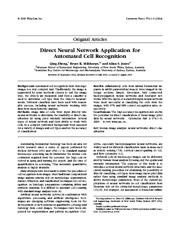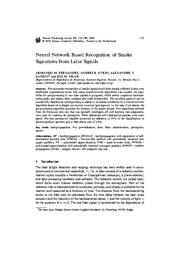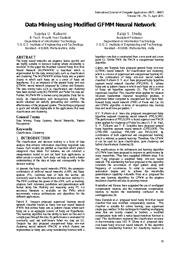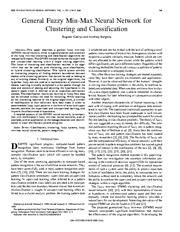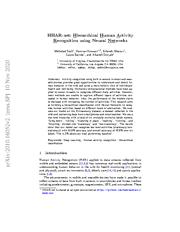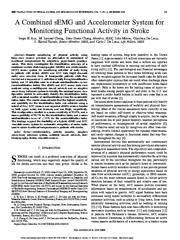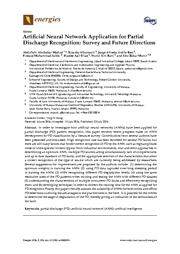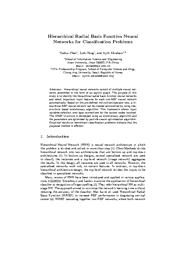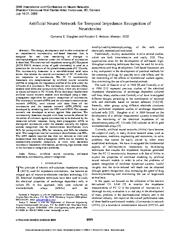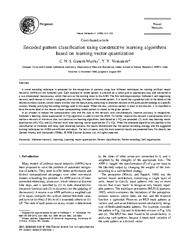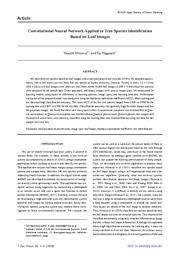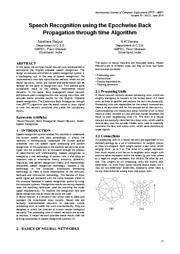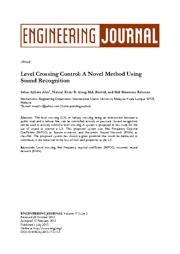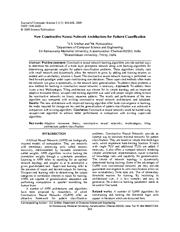A copy of this work was available on the public web and has been preserved in the Wayback Machine. The capture dates from 2017; you can also visit the original URL.
The file type is application/pdf.
Filters
Direct neural network application for automated cell recognition
2003
Cytometry
Several types of neural network and their ability to work with cells in a complex patterned background were assessed for a variety of images and cell types and for the accuracy of classification. ...
Simple, three-layer, fully connected, back-propagation neural networks and four-layer networks with two layers of a shared-weights neural network were most successful at classifying the cells from the ...
ACKNOWLEDGMENTS We thank the Australian Key Centre for Microscopy and Microanalysis, in Sydney University, for providing access to the equipment for image capturing in the study and the Department of Haematology ...
doi:10.1002/cyto.a.10106
pmid:14699600
fatcat:k3f6rodup5fz7a4wdp2zkqt5te
Neural Network Based Recognition of Smoke Signatures from Lidar Signals
2004
Neural Processing Letters
The automatic recognition of smoke signatures in lidar signals collected during very small-scale experimental forest fires using neural-network algorithms was studied. ...
The resulting patterns can be successfully classified as corresponding to alarm or no-alarm conditions by a neural-network algorithm based on a simple one-neuron structure (perceptron). ...
The performance of the simplest neural network represented by a perceptron was investigated in the present study. ...
doi:10.1023/b:nepl.0000035598.19042.42
fatcat:yktzhe2niragdahzfbgv5fx64i
Data Mining using Modified GFMM Neural Network
2015
International Journal of Computer Applications
The MGFMMNN utilizes fuzzy sets as pattern classes in which each fuzzy set is a union of fuzzy set hyperboxes. ...
It is an extension of the general fuzzy min-max (GFMM) neural network proposed by Gabrys and Bargiala. ...
This classifier when applied for rotation invariant handwritten character recognition problem, it performed better compared to unsupervised four layer feedforward fuzzy neural network (FNN) of Kwan and ...
doi:10.5120/20411-2786
fatcat:p3tgj6fwojgthirxsfh4usrlp4
General fuzzy min-max neural network for clustering and classification
2000
IEEE Transactions on Neural Networks
A detailed account of the GFMM neural network, its comparison with the Simpson's fuzzy min-max neural networks, a set of examples, and an application to the leakage detection and identification in water ...
This paper describes a general fuzzy min-max (GFMM) neural network which is a generalization and extension of the fuzzy min-max clustering and classification algorithms developed by Simpson. ...
Zurada which contributed to the improvement of the final version of the paper. ...
doi:10.1109/72.846747
pmid:18249803
fatcat:ufxdh3qpvfbzhhqj5hzhuj2pka
HHAR-net: Hierarchical Human Activity Recognition using Neural Networks
[article]
2020
arXiv
pre-print
This research aims at building a hierarchical classification with Neural Networks to recognize human activities based on different levels of abstraction. ...
Activity recognition using built-in sensors in smart and wearable devices provides great opportunities to understand and detect human behavior in the wild and gives a more holistic view of individuals' ...
As shown in
Deep Neural Networks Deep neural networks (DNN) are artificial neural networks (ANN) with more than one hidden layer. The schematic architecture of a DNN is shown in Figure 2 . ...
arXiv:2010.16052v2
fatcat:h4ciqsaigzatfgcjj2a3rxk3ty
A Combined sEMG and Accelerometer System for Monitoring Functional Activity in Stroke
2009
IEEE transactions on neural systems and rehabilitation engineering
This configuration resulted in a mean sensitivity of 95.0%, and a mean specificity of 99.7% for the identification tasks, and a mean misclassification error of 10% for the nonidentification tasks. ...
This study investigated the classification accuracy of a combined surface electromyographic (sEMG) and accelerometer (ACC) sensor system for monitoring activities of daily living in patients with stroke ...
obtained for the three-layer neural network with 44 and 22 neurons in the hidden layers. ...
doi:10.1109/tnsre.2009.2036615
pmid:20051332
pmcid:PMC2945210
fatcat:7ztu447saza3pdvneroftpnbxu
A Combined sEMG and Accelerometer System for Monitoring Functional Activity in Stroke
2010
IEEE transactions on neural systems and rehabilitation engineering
This configuration resulted in a mean sensitivity of 95.0%, and a mean specificity of 99.7% for the identification tasks, and a mean misclassification error of 10% for the nonidentification tasks. ...
This study investigated the classification accuracy of a combined surface electromyographic (sEMG) and accelerometer (ACC) sensor system for monitoring activities of daily living in patients with stroke ...
obtained for the three-layer neural network with 44 and 22 neurons in the hidden layers. ...
doi:10.1109/tnsre.2009.2039597
pmid:24760921
fatcat:brs7fak6frfndm4keaj5565uv4
Artificial Neural Network Application for Partial Discharge Recognition: Survey and Future Directions
2016
Energies
In order to investigate how artificial neural networks (ANNs) have been applied for partial discharge (PD) pattern recognition, this paper reviews recent progress made on ANN development for PD classification ...
Among them, the ANN is one of the most successful pattern recognition techniques because of its capability to learn input-output relationships from a few examples. ...
Conflicts of Interest: The authors declare no conflict of interest. Energies 2016, 9, 574 ...
doi:10.3390/en9080574
fatcat:ot6iprdviba5bdihd6ry52bzzi
Hierarchical Radial Basis Function Neural Networks for Classification Problems
[chapter]
2006
Lecture Notes in Computer Science
Hierarchical neural networks consist of multiple neural networks assembled in the form of an acyclic graph. ...
The purpose of this study is to identify the hierarchical radial basis function neural networks and select important input features for each sub-RBF neural network automatically. ...
Using Hierarchical RBF Paradigms
Iris Data Classification The iris data is a common benchmark in classification and pattern recognition studies [10] . ...
doi:10.1007/11759966_128
fatcat:yteunspl4bgbfkgqept334xzka
Artificial Neural Network for Temporal Impedance Recognition of Neurotoxins
2006
The 2006 IEEE International Joint Conference on Neural Network Proceedings
Three multilayer feedforward artificial neural network models were developed using a backpropagation algorithm for pattern recognition of neurotoxins. ...
The PC 12 neurotoxicity biosensors are complemented by artificial neural networks (ANNs) to recognize the impedance profiles of the cells under the influence of a neurotoxin. ...
ANNs to exploit the properties of nonlinear modeling by artificial neural network models in order to solve the problems of pattern recognition of nonlinear dynamical systems. ...
doi:10.1109/ijcnn.2006.246947
dblp:conf/ijcnn/SlaughterH06
fatcat:2f7rtvhucrd4phdxxbsyw27joi
Encoded pattern classification using constructive learning algorithms based on learning vector quantization
1998
Neural Networks
A novel encoding technique is proposed for the recognition of patterns using four different techniques for training artificial neural networks (ANNs) of the Kohonen type. ...
In an attempt to reduce the computational time and the size of the network, and simultaneously improve accuracy in recognition, Kohonen's learning vector quantization (LVQ) algorithm is used to train the ...
Acknowledgements The authors wish to thank the referees and the editor for their critical comments which have led to an improved, compressed version of the paper. ...
doi:10.1016/s0893-6080(97)00098-1
pmid:12662840
fatcat:w3lmaozpf5gzhok4hdbcuxcxce
Convolutional Neural Network Applied to Tree Species Identification Based on Leaf Images
2020
Journal of Forest Planning
We identified tree species based on leaf images with a convolutional neural network (CNN). We sampled approximately 200 to 300 leaves per tree from five tree species at Kyoto University Campus. ...
We constructed 36 learning models using based on differences in learning patterns, image types, and learning iterations. ...
Two anonymous referees provided valuable comments on earlier drafts of the manuscript. ...
doi:10.20659/jfp.2020.001
fatcat:tpfqw5hwejal5okw42cyg25tdi
Speech Recognition using the Epochwise Back Propagation through Time Algorithm
2014
International Journal of Computer Applications
We implemented a new data classification method, where we use neural networks, which are trained and performance can be defined on the basis of recognition rate. ...
The design an accurate and effective speech recognition system is a challenging task in the area of speech recognition. ...
An algorithm based on neural network classifier [8] for speech recognition used a new Viterbi net architecture which is recognized the input patterns and provided an accuracy of recognition rate more ...
doi:10.5120/16718-7036
fatcat:cmsgj3sgnrdsnnsdlqt4beskoe
Level Crossing Control: A Novel Method Using Sound Recognition
2013
Engineering Journal
Sound recognition can be used to actively control a level crossing. A system is proposed in this study for the use of sound to control a LX. ...
This proposed system uses Mel Frequency Cepstral Coefficient (MFCC) as feature extractor, and Recurrent Neural Network (RNN) as classifier. ...
Recurrent Neural Network (RNN) The architecture of Recurrent Neural Network requires a number of input layer neurons, hidden layer neurons and output layer neuron. ...
doi:10.4186/ej.2013.17.3.113
fatcat:3w576xt7grgvhagdh5gtbsmfsu
New Constructive Neural Network Architecture for Pattern Classification
2009
Journal of Computer Science
Problem statement: Constructive neural network learning algorithms provide optimal ways to determine the architecture of a multi layer perceptron network along with learning algorithms for determining ...
The results and performance of the new algorithm was compared with existing constructive neural network architectures and tabulated. ...
Fig. 1 : 1 New MTiling I-ART constructive neural network architecture Fig. 2: New MTiling algorithm • Each hidden layer (or) recognition layer and output layer maintains a set of master neurons which correctly ...
doi:10.3844/jcssp.2009.843.848
fatcat:qxbgmbrepbaehhk4syx3jwhjaq
« Previous
Showing results 1 — 15 out of 11,099 results

